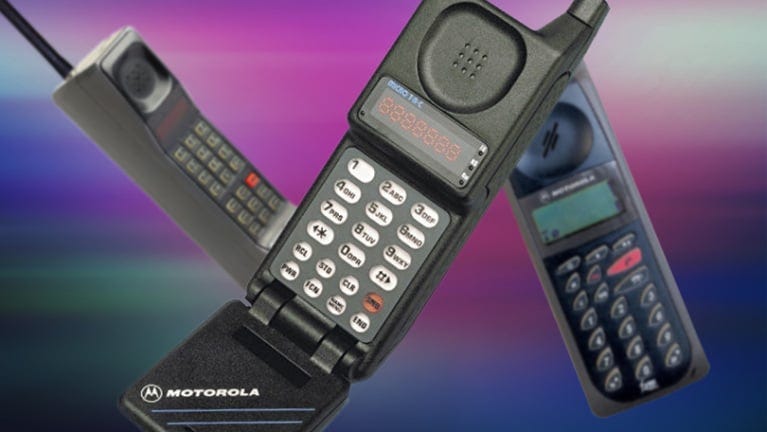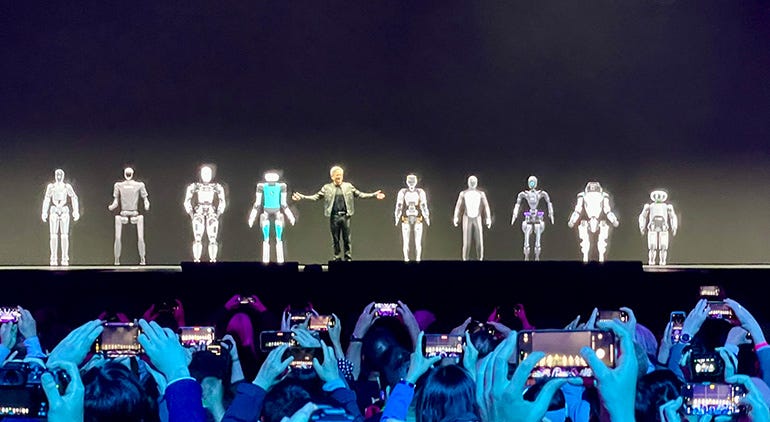The Robots are Learning to Dance (And Why That Changes Everything)
The Golden Age of Motorola Cell Phones - https://www.pcmag.com/news/the-golden-age-of-motorola-cell-phones
Imagine traveling back to 1995 and showing someone a cell phone. Now imagine traveling back from 2035 and showing us this dancing robot. The surreal three-minute video you are about to watch isn't just a tech demo—it's a time machine, offering a glimpse into a world where the line between human and artificial intelligence doesn't just blur, it disappears entirely. And like every revolution, it starts with something that looks relatively simple.
I recently watched Tesla's Optimus robot performing a remarkably fluid dance routine, and found myself both impressed and contemplative about the technical achievement it represents. Behind this seemingly simple demonstration lies a fascinating process that's part magic trick, part cutting-edge engineering.
Below is the video of Optimus dancing. Please pause here and watch it before continuing:
How to Train Robots to Dance
How do you teach a machine made of metal and motors to move with the grace of a human dancer? The process begins much like how you might learn a dance—by watching someone else do it first.
Engineers start by filming a human dancer with an ordinary camera. Then, they create detailed three-dimensional models of human movement and advanced computer vision systems dissect every frame with superhuman precision, measuring the exact angle of every joint, the precise timing of weight shifts, the subtle coordination between body parts that our eyes could never track. They're creating an impossibly detailed instruction manual written in the language of mathematics.
Think of it as creating an incredibly detailed instruction manual for the dance, written in the language of numbers and coordinates rather than "step to the left, then spin."
Next comes the virtual training phase. Before any physical robot attempts these movements, a digital version of the robot practices in a simulated world that mirrors reality down to microscopic detail. This isn't a simple video game environment. Engineers build a digital universe that mimics reality down to extraordinary detail—how gravity works, how friction affects movement, how much energy each motor consumes, even how parts heat up during operation. It's like creating a physics-perfect simulation of our world where a digital robot can practice safely.
Here's the remarkable part: this virtual robot practices the same dance thousands of times, learning through what's called reinforcement learning—essentially trial and error on steroids. Each time it attempts the dance, the system scores how well it did. Did it maintain balance? Did the movements flow smoothly? Did it look like the human dancer?
The robot adjusts its approach based on this feedback and tries again. And again. And again. Thousands of times faster than would be possible in the real world.
But here's where things get tricky. Getting a robot that's perfect at dancing in a virtual world to dance well in the real world is like the difference between being great at a driving simulator versus actually driving a car. Everything feels different.
This challenge is called the "sim-to-real gap," and it's where many robotics projects have stumbled. Real motors don't respond exactly like simulated ones. Real joints have tiny amounts of play and friction. Real sensors pick up noise and have slight delays.
To bridge this gap, engineers create what's called a "shim layer"—think of it as a translator that sits between the robot's AI brain and its physical body. This translator learns the unique personality of each individual robot.
Just like no two people are exactly alike, no two robots are identical, even when built on the same assembly line. One might have slightly more friction in a joint, another might have a motor that responds just a bit differently. The shim layer learns these individual quirks and compensates for them in real-time.
It's remarkably similar to how your brain automatically adjusts for the fact that your left leg might be slightly different from your right, or how you unconsciously compensate when you're carrying something heavy.
Finally, the learned skills are transferred to the physical robot which should perform the skill on the first try. This approach, often referred to as "zero-shot" learning, allows Optimus to develop skills like walking and dancing without direct programming for each specific action.
But Tesla isn't operating in isolation—this breakthrough is happening amid fierce global competition.
NVIDIA CEO Jenson Huang ended his GTC 2024 keynote presentation backed by images of all of the various humanoid robots currently on the market that are powered by the Jetson Orin computer.
The Competition Context: A Race Against Time
While Tesla's dance demonstration captured headlines, it's worth understanding this isn't happening in a vacuum. Just as the cell phone revolution saw multiple companies racing to define the future, Companies like Unitree, a Chinese robotics company have shown similar dancing capabilities months earlier, with some observers noting that competing robots move with more balance and fluidity.
The humanoid robotics space has become intensely competitive, with Chinese and companies like Boston Dynamics (owned by Hyundai), Figure AI, Apptronik, Agility Robotics, and several Chinese manufacturers all making significant advances. This competitive pressure is driving rapid innovation across the industry—much like the early days of personal computing or mobile phones, when breakthroughs came in months rather than years.
The Advantage of Building Everything Yourself
Tesla has a secret weapon in this process: they build their own robots from scratch. This means they know exactly how every actuator, sensor, and joint behaves because they designed and manufactured them.
It's like a race car team that builds their own engine versus one that buys engines from a supplier. The team that builds their own engine knows exactly how it performs at different temperatures, how it responds to different fuel mixtures, and precisely how much power it produces at every RPM. When they create a racing simulator for their drivers to practice on, they can make it incredibly accurate because they understand every component intimately.
In contrast, a team using a supplier's engine has to work with general specifications and hope their simulator is close enough. When you control every aspect of the hardware, you can create virtual training environments that mirror reality with remarkable precision. This technical mastery translates into capabilities that extend far beyond entertainment.
Why This Matters Beyond Dancing
While watching a robot dance is entertaining, the same technology that enables Optimus to move gracefully has profound practical applications:
A robot that can maintain balance while dancing can work on construction sites with uneven surfaces. The hand-eye coordination needed for graceful arm movements becomes the precision required for assembling electronics. The ability to learn complex movement sequences through observation means robots could master surgery by watching expert surgeons, or learn cooking techniques by studying celebrity chefs. The fluid movement and balance required for dancing translates directly to thousands of real-world challenges. What makes this even more powerful is how the technology improves itself.
The Continuous Improvement Cycle
Perhaps the most fascinating aspect is how this creates a cycle of continuous improvement. The robot practices in simulation, performs in reality, and engineers use that real-world data to make the simulations even more accurate. Better simulations lead to better robot performance, which leads to better data, which leads to even better simulations.
Picture this cycle: The virtual robot masters a spinning move. The physical robot attempts it but stumbles—sensors capture exactly what went wrong. Engineers feed this data back into the simulation, which now includes more accurate real-world variables. The robot retrains on the improved simulation and tries again. This time it succeeds, but discovers a balance technique that's actually more efficient than what humans use.
Now imagine this happening across dozens of movements, with multiple robots contributing data, running 24/7. Each robot's experience makes every simulation more accurate, improving training for all robots. The rate of improvement accelerates exponentially.
It's a flywheel effect that means each generation of dancing robots will be more graceful than the last. And just when this flywheel effect was gaining momentum, Tesla announced something that accelerated everything.
The YouTube Breakthrough: When the Future Arrives Early
Just as this article was being written, Tesla announced a breakthrough that feels like it belongs in that imagined 2035 world: Optimus robots can now learn tasks by watching YouTube videos, just like humans do.
"If Optimus can watch videos, YouTube videos or how-to videos or whatever, and based on that video, just like a human can, learn how to do that thing," Elon Musk explained to CNBC, "then you really have task extensibility that is dramatic, because it can learn anything very quickly."
This is the smartphone moment for robotics. Just as phones became computers became cameras became maps became everything, robots are becoming universal learning machines. The Tesla team has already demonstrated that robots can learn from first-person demonstration videos, with the next step being learning from third-person internet videos. This YouTube learning capability enables something even more transformative: a global skills network.
Sico, Paulie’s Robot from Rocky 4. 1985.
The Skills Marketplace: One Robot Learns, Millions Benefit
Once a single robot masters a skill—whether it's dancing, folding laundry, or cooking—that learned behavior can potentially be packaged and distributed to millions of other robots instantly.
Imagine a robot in Italy learns to perfectly prepare “Mama Leoni's” famous pasta marinara recipe—not just following written instructions, but mastering the subtle physical skills: how to tell when the garlic is perfectly golden by the sound of the sizzle, the exact wrist motion for tossing pasta, how much pressure to apply when grating cheese. Once this robot has mastered these techniques, that knowledge could be packaged and downloaded by robots worldwide.
Mama Leonie’s Pasta Marinara produced by Midjourney.
Within hours, a robot in Tokyo could be preparing authentic Italian pasta with the same nuanced techniques, and a robot in New York could be replicating Mama Leoni's exact cooking style. It's like having the world's greatest chefs teaching their signature moves to millions of students simultaneously.
This isn't as simple as copying a file, though. Remember that shim layer we discussed? Each robot needs its own personalized translation layer to account for its unique physical characteristics. So the "skill download" would include both the core movement patterns and the ability to adapt those patterns to each robot's individual quirks—ensuring the pasta comes out perfect whether the robot has slightly different grip strength or arm length.
The implications are staggering. Instead of training every robot from scratch for every new task—which would take enormous computational resources and time—you could have specialized "training robots" that master new skills, then distribute that knowledge across an entire fleet.
Imagine a future where breakthrough techniques discovered by one robot—perhaps a more efficient way to fold fitted sheets or a gentler method for handling delicate ingredients—could propagate across millions of robots overnight. The rate of capability improvement could accelerate exponentially as the robot population grows and contributes to this shared knowledge base.
Looking Forward
The technical foundations demonstrated in dancing robots are rapidly evolving. We're seeing advances in more efficient training methods, better techniques for transferring virtual skills to reality, and systems that can adapt to new movements in real-time.
The intersection of AI, robotics, and precision engineering required to make a robot dance gracefully represents some of the most challenging technical work happening today. The breakthrough isn't just that robots can move—it's that they can learn to move by watching us, practicing virtually, and improving continuously. Unlike previous generations of industrial robots that required safety cages and rigid environments, these learning-capable robots are designed to share our spaces and adapt to our unpredictable world.
Welcome to Tomorrow
We're witnessing the foundation of a technology that will fundamentally change how machines interact with our physical world—just as the first clunky cell phones hinted at a world where everyone would carry supercomputers in their pockets.
The robots are learning to move among us—and now they're learning from watching us on YouTube. The smartphone transformed how we access information. The humanoid robot might transform how intelligence itself moves through the world.
We're not just watching entertainment. We're watching tomorrow's world taking its first steps.
And tomorrow is arriving faster than we think.
Whatever you do, Ignore the Confusion!
This post was written with help from Claude.






